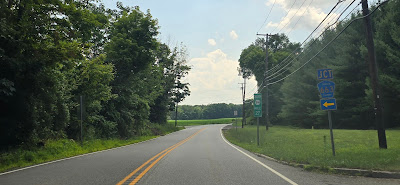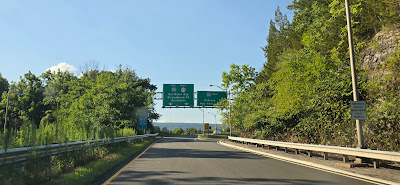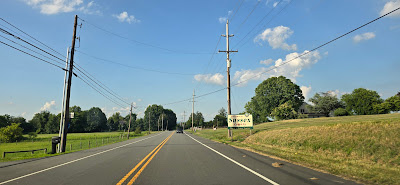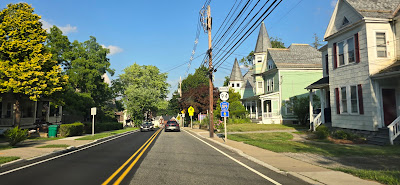
A diagonal route. From the Portland-Columbia Toll Bridge to the NJ/NY line.
NJ 94 starts midspan of the Portland-Columbia Toll Bridge, but there is a stretch of road between PA 611 (the end of the bridge) and the actual start of NJ 94 at the PA/NJ line. This was relevant to the NJ 94 page, so it goes here.
Why does PA 611 exit itself and NJ 94* serve as the mainline? Here's why: This bridge used to be US 611. US 611 followed the Portland-Columbia Toll Bridge, then I-80 along the eastern / left bank of the Delaware River before returning to Pennsylvania. Current PA 611 along the western / right bank of the Delaware used to be US 611 Alternate. However, US 611 was deleted from the highway system in 1972 and the route was renumbered PA 611. Doesn't make sense for a PA route to be in New Jersey. So, PA 611 usurped US 611 Alternate, and the Portland-Columbia Toll Bridge became an extension of NJ 94**.
**NJ 94 signage does not start until after I-80.


The toll plaza for the Portland-Columbia Toll Bridge.
At midspan, NJ 94 starts.
An overhead sign indicating three possible routes to follow from the Portland-Columbia Toll Bridge. NJ 94 is what this road is.
Why are Stroudsburg and Scranton control cities? Here's why: see the US 611 explanation for why Stroudsburg and Scranton are control cities. I guess these are still up because PA 611 from Portland to Stroudsburg is truck-restricted, so trucks on PA 611 would be diverted onto NJ 94 and I-80 to reach Stroudsburg and Scranton.
NJ 94 weaves through the tangled mess that is the I-80 / US 46 / NJ 94 interchange, combined with local access to Columbia. The concrete-paved streets in Columbia, as well as US 46 from NJ 163 to the start of present-day NJ 94, used to be NJ 94 / NJH 8 (old designation of NJ 94).
NJ 94 passes under the Lackawanna Cut-Off (dated to 1910). There is another tunnel on the left of this photo for an access road for Tunnel Field, local recreation fields. Why is there a second tunnel? Was it because the railway engineers of the time knew that Tunnel Field would be built so that kids could play ball? Not necessarily. That tunnel was supposed to be for the Lehigh and New England Railroad, a rail line that was built but was never used through this region of New Jersey.
NJ 94 in Hainesburg.
Along Warren CR 660, old NJH 8 (predecessor of NJ 94) in the Blairstown Historic District. NJ 94 was rerouted to avoid the town center.
CR 660 at CR 602. Warren County recreated a historic sign's text with modern panels and fonts. Although I don't like the font here because of how ugly it is. And the signs for Portland and Water Gap are incorrect because CR 660 was converted to a one-way eastbound only street.
NJ 94 has a short, wrong-way concurrency with CR 521 near Blairstown. The route from Hainesburg to Blairstown is actually a straightening of former NJH 8 known as the Blairstown Bypass.
NJ 94 in Paulina.
NJ 94 crosses from Warren to Sussex County.
NJ 94 in Newton, where it multiplexes with CR 519 (short multiplex) and US 206 (longer multiplex). In fact, through central Newton, NJ 94, US 206, and CR 519 have a triplex. See the US 206 page for the NJ 94 multiplexes with both roads.

NJ 94 splits from US 206 to have a short, wrong-way concurrency with NJ 15 in Lafayette.

NJ 94 intersects Church Road to connects NJ 94 to Franklin.
NJ 94 intersects NJ 23 in Hamburg. Even if NJ 23 doesn't reach Montclair, it is a control city for historical purposes (NJ 23's predecessor, the Newark-Pompton Turnpike reaches Montclair from Hamburg [by way of the Paterson-Hamburg Turnpike]). NJ 23 is also the best route from Montclair to Hamburg.
NJ 94 has a short wrong-way overlap with CR 517.
NJ 94 passes by Mountain Creek.



.jpg)




















.jpg)










.jpg)
.jpg)











.jpg)


.jpg)
No comments:
Post a Comment